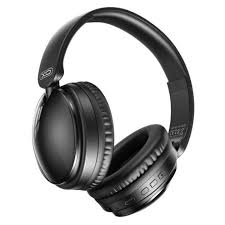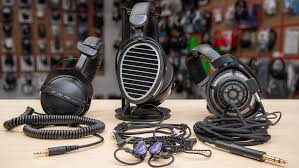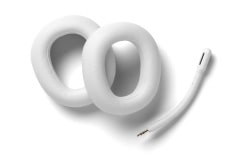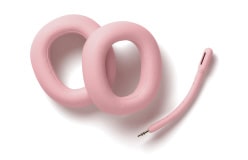Wireless and Bluetooth Headphones
These headphones use various wireless technologies, such as RF (radio frequency) or infrared, to communicate with a paired device. They typically offer a greater range than Bluetooth headphones, with some models allowing users to move up to 100 feet from the connected device. Wireless headphones can be ideal for users who need mobility around larger spaces, such as home entertainment setups.
- Connection Type: RF, Infrared, or proprietary wireless protocols
- Range: Up to 100 feet or more
- Battery Life: Often longer than Bluetooth headphones
- Advantages:
- Wider range for more freedom of movement
- No interference from Bluetooth signals
- Disadvantages:
- May require a separate transmitter plugged into the audio source
- Bulkier and less portable than Bluetooth models
Bluetooth Headphones
Bluetooth headphones, on the other hand, use Bluetooth technology to connect wirelessly to devices like smartphones, laptops, and tablets. The connection is established using a pairing process, where the headphones and the device communicate via low-energy Bluetooth signals. Bluetooth headphones are more portable and are widely used for everyday tasks such as commuting, exercising, or casual listening.
- Connection Type: Bluetooth 4.0 or newer (often 5.0 or 5.1 for better range and efficiency)
- Range: Typically 30 feet (10 meters), though newer versions offer improved range
- Battery Life: Generally lasts 6-30 hours, depending on the model and usage
- Advantages:
- Convenient and easy to pair with Bluetooth-enabled devices
- Compact and portable, perfect for on-the-go use
- Low power consumption in newer Bluetooth versions
- Disadvantages:
- May experience connectivity issues like lag or dropouts
- Limited range compared to RF wireless headphones
- Sound quality can degrade, especially at longer ranges

- Listening to Music:
Enjoy high-quality, wireless audio without the hassle of tangled cords. - Hands-Free Calls:
Make and receive calls with built-in microphones, perfect for driving or multitasking. - Gaming:
Provide immersive sound experiences with low latency for competitive gaming. - Fitness and Workouts:
Ideal for running, gym sessions, or outdoor activities, offering freedom of movement. - Virtual Meetings:
Essential for video conferencing, ensuring clear audio during professional calls. - Travel:
Noise-canceling models help block out background noise on planes, trains, or buses. - Watching Movies/TV:
Enjoy cinematic sound quality without disturbing others. - Learning and Education:
Useful for online classes, language learning apps, and educational podcasts. - Voice Assistants:
Integrated with virtual assistants like Siri, Google Assistant, or Alexa for quick commands. - Content Creation:
Great for monitoring audio while recording podcasts, vlogs, or editing videos.







- Freedom of Movement:
No tangled wires, making them perfect for workouts, commuting, and daily activities. - Portability:
Lightweight and compact, easy to carry around without dealing with cords. - Convenient Connectivity:
Quick pairing with smartphones, tablets, laptops, and other Bluetooth-enabled devices. - Hands-Free Functionality:
Built-in microphones allow you to take calls, use voice assistants, and control music without touching your device. - Improved Battery Life:
Modern headphones offer long-lasting battery performance, with many providing 20+ hours of playback. - Noise Cancellation:
Advanced models feature Active Noise Cancellation (ANC) for immersive listening, especially in noisy environments. - Stylish Designs:
Sleek, modern aesthetics with various styles like over-ear, on-ear, and in-ear options. - Multipoint Connectivity:
Some models can connect to multiple devices simultaneously, allowing easy switching between devices. - High-Quality Audio:
Enhanced audio codecs (like aptX, AAC, LDAC) deliver excellent sound quality, rivaling wired headphones. - Durability:
No fragile wires that can break over time, making them more durable for everyday use.

Wireless and Bluetooth headphones have revolutionized the way we experience audio, offering unparalleled convenience, mobility, and advanced features. They eliminate the hassle of tangled cords, providing seamless connectivity with smartphones, laptops, and other Bluetooth-enabled devices. With benefits like hands-free calling, noise cancellation, and long battery life, these headphones are perfect for a wide range of activities, including workouts, travel, gaming, and professional use. Their sleek designs, superior sound quality, and easy portability make them a popular choice for both casual listeners and audiophiles alike.
I’ve condensed the document into a single comprehensive paragraph, highlighting the key features and benefits of wireless and Bluetooth headphones. Let me know if you’d like any further adjustments!



Table of Contents
Wireless and Bluetooth headphones have become increasingly popular due to their convenience and advanced features. Unlike traditional wired headphones, they offer the freedom to move without being tethered to your device, making them ideal for workouts, commuting, or simply enjoying music without the hassle of cables. Bluetooth headphones connect seamlessly to smartphones, laptops, tablets, and other Bluetooth-enabled devices, providing high-quality sound and clear communication for calls and media playback. With varying designs, from over-ear to in-ear models, these headphones come with features like noise cancellation, long battery life, and touch controls, ensuring a personalized and comfortable audio experience. Whether for everyday use, travel, or intense workouts, wireless and Bluetooth headphones cater to diverse needs and preferences.
While wireless and Bluetooth headphones offer many benefits, they also come with a few disadvantages. One of the main drawbacks is their reliance on battery power, meaning they need to be charged regularly. If the battery runs out during use, they can become unusable until recharged, which can be inconvenient. Additionally, the sound quality of Bluetooth headphones may not always match that of wired headphones, especially in lower-end models, due to compression during wireless transmission. Bluetooth connectivity can also be unstable at times, with potential issues like lag, dropouts, or interference from other wireless devices. Lastly, these headphones are typically more expensive than their wired counterparts, and their lifespan can be limited if the battery degrades over time.
